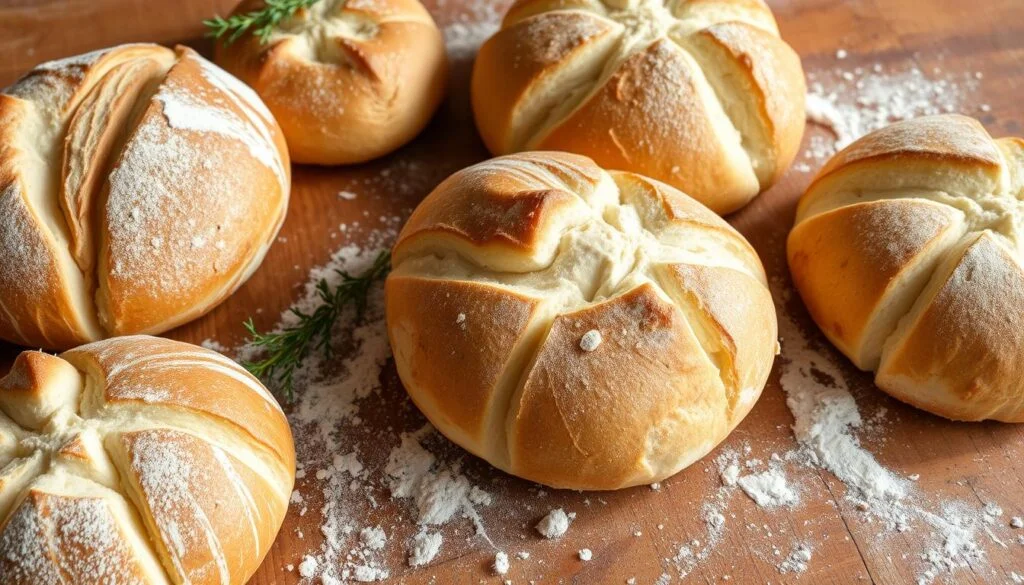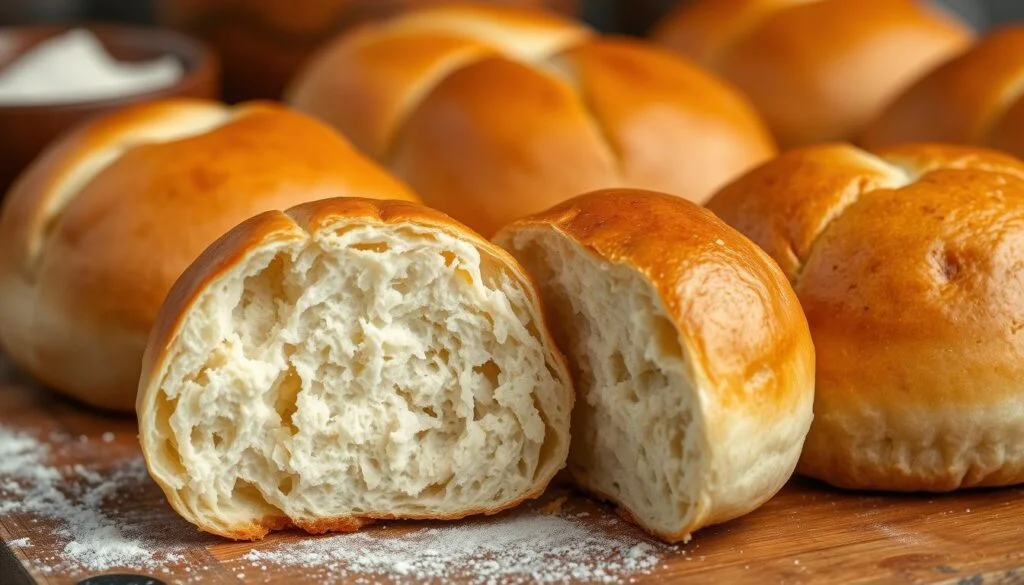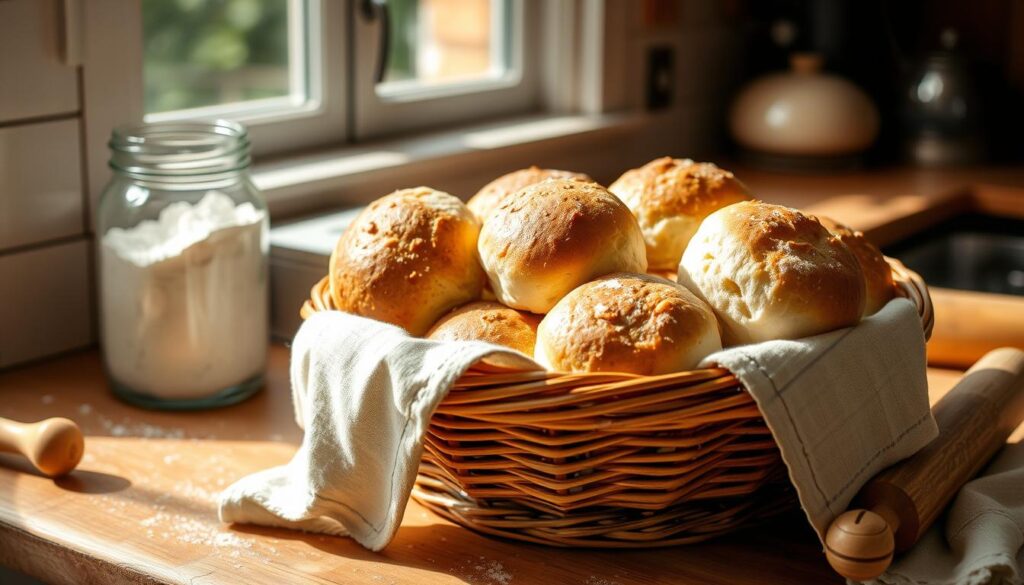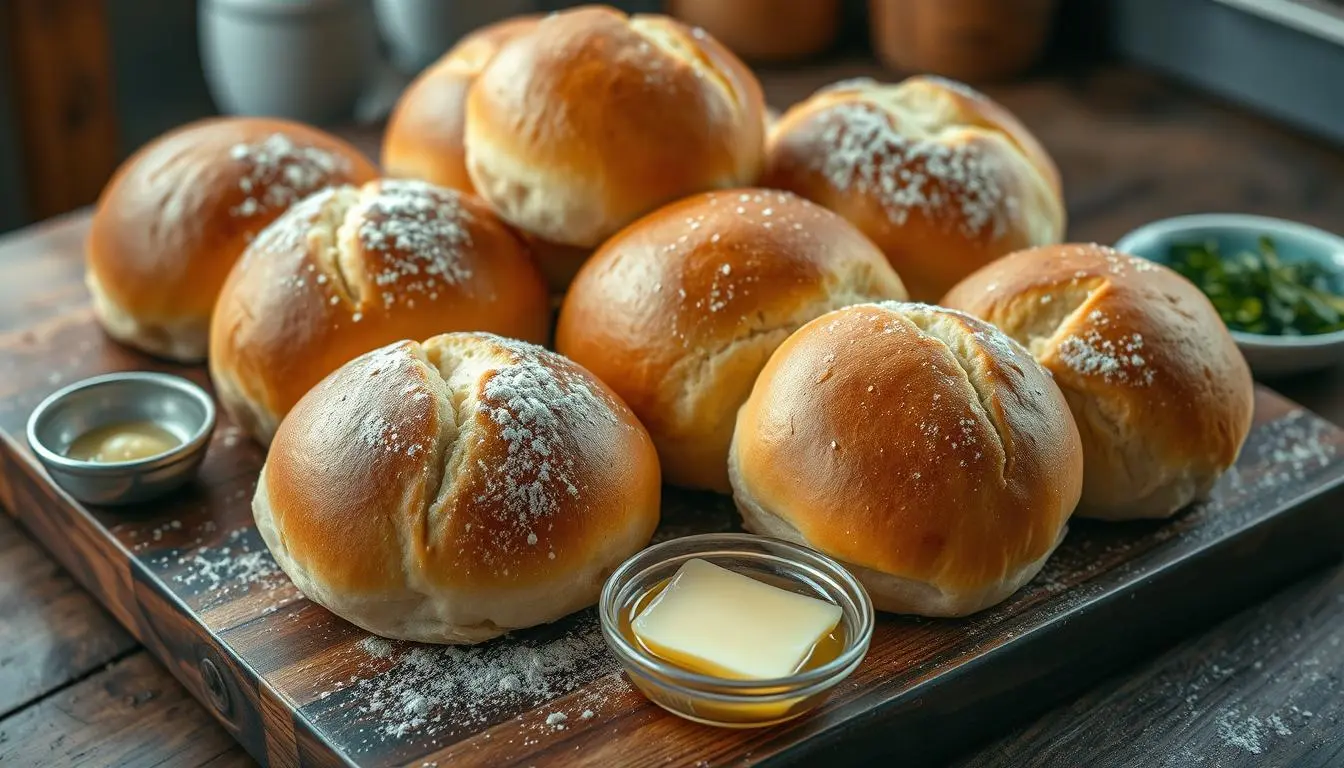Table of Contents
The smell of sourdough dinner rolls baking fills your kitchen. It takes you to a place of comfort and warmth. When you open a roll, steam comes out, showing a crumb that’s centuries old. It’s not just bread; it’s history, human skill, and a tasty addition to your meals.
In 2025, making sourdough dinner rolls has become even better. This guide will help you, whether you’re new to baking or experienced. You’ll learn how to make your own starter and master advanced techniques. Soon, you’ll be baking rolls that impress any artisan baker.
Get ready for a journey that mixes science, tradition, and creativity. You’ll learn to make wild yeasts create unique flavors. By the end, you’ll be making homemade rolls that are more than food; they’re edible art.
Sourdough dinner rolls
- Master the art of sourdough starter creation and maintenance
- Learn essential techniques for kneading and shaping perfect dinner rolls
- Discover the science behind fermentation for optimal flavor development
- Explore creative variations to customize your sourdough dinner rolls
- Understand proper storage and reheating methods for lasting freshness
Understanding the Magic of Sourdough Dinner Rolls
Sourdough bread has been a favorite among bakers for centuries. Its unique flavor and texture are thanks to a natural process. This process is different from how regular yeast breads are made.
The Science Behind Natural Fermentation
Sourdough uses wild yeasts and bacteria found in the air to ferment. This method is called yeast-free baking. It creates a living part in your bread.
As the dough ferments, it makes lactic acid. This gives sourdough its tangy taste and helps it last longer.
Benefits of Sourdough Over Commercial Yeast
Sourdough has many benefits over bread made with commercial yeast:
- It’s easier to digest because gluten breaks down during fermentation
- It has a lower glycemic index, which is good for blood sugar
- The fermentation process makes nutrients more available
- It stays fresh longer without needing artificial preservatives
Historical Significance of Sourdough Baking
Sourdough has a long history, dating back thousands of years. Ancient Egyptians first used natural fermentation to leaven bread. This method spread to many cultures.
Today, sourdough is loved for its artisanal quality and connection to old baking ways.
Essential Equipment for Perfect Sourdough Rolls
Making artisan rolls needs the right tools. Your bread baking journey begins with quality equipment. Let’s look at the must-have items for perfect sourdough dinner rolls.
A large mixing bowl is key for mixing ingredients and starting the dough. Choose stainless steel or glass for easy cleaning. For proofing, get a banneton basket. It helps shape your dough and adds beautiful patterns to your rolls.
A sturdy baking stone spreads heat evenly, making crusts crispy. Don’t forget a sharp bread lame for scoring your rolls before baking. This lets them expand properly and look great.
- Digital kitchen scale for precise measurements
- Dough scraper for handling sticky dough
- Proofing box to control temperature and humidity
- Spray bottle for creating steam in the oven
Think about using a Dutch oven for rolls with an extra crispy crust. Its closed environment traps steam, like a professional bread oven.
| Equipment | Purpose | Impact on Rolls |
|---|---|---|
| Mixing Bowl | Ingredient combination | Even distribution of ingredients |
| Banneton Basket | Dough proofing | Proper shape and texture |
| Baking Stone | Heat distribution | Crispy, evenly baked crust |
| Bread Lame | Dough scoring | Controlled expansion and design |
With these tools, you’re set to improve your artisan rolls. Remember, good equipment boosts your bread baking skills and leads to tasty results every time.
Creating and Maintaining Your Sourdough Starter
The heart of sourdough bread is its starter. This mix of fermented dough captures wild yeast and bacteria. It gives your bread its unique flavor and texture. Let’s explore how to create and care for your sourdough starter.
Building a Healthy Starter from Scratch
To start, mix equal parts flour and water in a clean jar. Let it sit at room temperature for 24 hours. Each day, toss half and add fresh flour and water.
After a week, you’ll see bubbles and smell a tangy aroma. These are signs your starter is alive and growing.
Feeding Schedule and Maintenance Tips
When your starter is active, feed it regularly. For the best results, feed it twice a day at room temperature. If you bake less, store it in the fridge and feed it once a week.
Always use clean tools to avoid contamination.
Troubleshooting Common Starter Issues
Sourdough starters can be tricky. If your starter smells bad or has mold, it’s time to start over. A slow starter might need more food or warmer places.
Remember, making sourdough bread takes patience.
| Issue | Possible Cause | Solution |
|---|---|---|
| No bubbles | Inactive yeast | Increase feeding frequency |
| Foul odor | Bacterial contamination | Discard and start fresh |
| Liquid on top | Hunger | Feed more often |
Key Ingredients for Artisanal Sourdough Dinner Rolls
Making perfect sourdough dinner rolls begins with choosing the best ingredients. The quality of what you use affects the taste, texture, and success of your rolls.
Flour is the main ingredient in your sourdough dinner rolls. Choose unbleached bread flour for its high protein content. This protein helps create gluten, giving your rolls a chewy texture. If you prefer whole grains, try whole wheat or rye flour blends for more flavor and nutrition.
Water quality is important too. Tap water with chlorine can slow down fermentation. Use filtered or spring water for better results. The amount of water in your dough also affects the texture of your rolls, so measure it carefully.
Salt is key for flavor and dough strength. Use fine sea salt or kosher salt for even distribution. Remember, a small amount is enough – usually 1.8% to 2% of the flour weight.
- Optional add-ins for flavor variations:
- Herbs (rosemary, thyme, basil)
- Seeds (sesame, poppy, pumpkin)
- Nuts (walnuts, pecans)
- Dried fruits (raisins, cranberries)
By using high-quality ingredients, you can make your sourdough dinner rolls truly special. Try different combinations to create unique, artisanal rolls that will wow your family and friends.
Mastering the Basic Sourdough Dinner Rolls Recipe
Making perfect sourdough dinner rolls is an art. With the right techniques, your homemade rolls can be as good as those from a bakery. Let’s explore the key steps to making these tasty treats.
Mixing and Kneading Techniques
Begin by mixing your sourdough starter with flour, water, and salt. Mix until the dough forms. Then, knead for 10-15 minutes to build gluten. This makes your rolls strong.
You’ll know it’s done when the dough feels smooth and elastic.
Bulk Fermentation Process
After kneading, let the dough rest for 4-6 hours at room temperature. This step lets flavors grow and the dough to rise. Every hour, stretch and fold the dough to make it even stronger.
Shaping Perfect Rolls
Split your dough into equal parts. Shape each into a tight ball by folding the edges to the center and rolling. Place the rolls in a greased pan, cover, and let them rise for 2-3 hours before baking.
| Step | Time | Key Points |
|---|---|---|
| Mixing and Kneading | 15-20 minutes | Develop gluten structure |
| Bulk Fermentation | 4-6 hours | Stretch and fold hourly |
| Shaping | 10-15 minutes | Create tight surface tension |
| Final Rise | 2-3 hours | Allow rolls to double in size |
Advanced Shaping Techniques for Beautiful Presentation

Take your bread making to the next level with advanced shaping techniques for artisan rolls. These methods not only make your bread look great but also improve its taste and texture.
Braided rolls are a stunning choice. Begin by splitting your dough into three equal parts. Roll each part into a rope, then braid them together, securing the ends underneath. This method produces a stunning pattern and a special eating experience.
Knot rolls offer a more complex design. Roll your dough into a rope, then tie it into a loose knot. Fold the ends under to form a round shape. As it rises and bakes, the knot’s details become more visible, making it a standout.
Try spiral shapes for a captivating look. Roll your dough into a thin rectangle, then roll it up tightly from one end. Cut the roll into pieces and place them in your baking pan, cut-side up. The spiral design will emerge as the rolls expand and bake.
Remember, getting better at these techniques takes practice. Don’t worry if your first tries aren’t perfect. With time and effort, you’ll make artisan rolls that are as tasty as they are beautiful.
Understanding Fermentation Times and Temperature Control
Mastering sourdough bread means knowing about fermentation times and temperature control. These are key to getting the right flavor and texture. Let’s look at how the environment affects your sourdough and how to adjust your baking as the seasons change.
Impact of Environmental Factors
Your kitchen’s temperature and humidity really matter for sourdough fermentation. Warmer places make it go faster, while cooler ones slow it down. Humidity also changes how wet the dough is, which can affect how fast it ferments. To get consistent results, keep an eye on these factors and tweak your recipe as needed.
Seasonal Adjustments for Perfect Results
As the seasons shift, so should your sourdough baking. In summer, make the fermentation times shorter and use cooler water to slow it down. In winter, let it ferment longer and use warmer water to help the yeast work better. These tweaks will keep your sourdough bread tasting great all year.
| Season | Temperature (°F) | Fermentation Time | Water Temperature |
|---|---|---|---|
| Summer | 75-85 | 4-6 hours | 65-70°F |
| Winter | 65-70 | 8-12 hours | 80-85°F |
| Spring/Fall | 70-75 | 6-8 hours | 75-80°F |
By adjusting your fermentation times and temperature, you’ll make delicious sourdough bread all year. Remember, the more you practice, the better you’ll get. So, don’t hesitate to try new things and find what works best for you.
Achieving the Perfect Crust and Crumb Structure

Mastering crusty dinner rolls is a key skill in bread baking. The secret lies in creating a crispy exterior while maintaining a soft, airy interior. To achieve this balance, focus on three crucial elements: steam, scoring, and temperature.
Steam plays a vital role in crust formation. Place a pan of hot water in the oven as you bake your rolls. This creates a moist environment, allowing the crust to expand before setting. Remove the water pan halfway through baking to let the crust crisp up.
Scoring your rolls before baking helps control their expansion. Use a sharp blade to make shallow cuts on the surface. This not only adds visual appeal but also allows for even rising and a better crust texture.
Temperature control is crucial for ideal crust and crumb structure. Start baking at a high temperature (around 450°F) to create steam and promote initial rise. Then, lower the temperature to about 375°F to finish baking. This method ensures a crispy crust and a soft interior.
For the perfect crumb, handle your dough gently during shaping. This preserves air bubbles formed during fermentation, resulting in a light, airy texture. Remember, practice makes perfect when it comes to bread baking!
Flavor Variations and Creative Add-ins
Make your tangy bread rolls even better with exciting flavors and add-ins. Try different ingredients to turn your rolls into special treats.
Herb and Garlic Combinations
Add herbs and garlic to your sourdough dinner rolls for a great taste. Mix in rosemary, thyme, or sage for a Mediterranean flavor. For a strong taste, add roasted garlic cloves.
Sweet and Savory Options
Create rolls that please everyone by making both sweet and savory ones. Add dried fruits like cranberries or raisins for sweetness. For savory, mix in sun-dried tomatoes, olives, or caramelized onions.
These rolls are great with many dishes.
Multi-grain Variations
Make your rolls healthier and tastier with multi-grain options. Try using whole wheat, rye, or spelt flour. Add sunflower, pumpkin, or flax seeds for crunch.
These rolls are perfect for sandwiches or with salads.
| Variation | Ingredients | Pairing Suggestion |
|---|---|---|
| Rosemary Garlic | Fresh rosemary, roasted garlic | Grilled chicken |
| Cranberry Walnut | Dried cranberries, chopped walnuts | Cheese platter |
| Seeded Whole Wheat | Whole wheat flour, mixed seeds | Hearty soups |
Proper Storage and Reheating Methods

Mastering homemade rolls is more than just baking. It’s about keeping them fresh and delicious. Let’s look at the best ways to store and reheat your sourdough dinner rolls.
For short-term storage, keep your rolls in an airtight container or bread box at room temperature. They’ll stay fresh for 2-3 days. If you need to store them longer, freeze them. Wrap each roll in plastic wrap, then put it in a freezer bag. They can last up to 3 months frozen.
When it’s time to enjoy your rolls, reheating is important. Warm room temperature rolls in a 350°F oven for 5-7 minutes. Frozen rolls take about 10-12 minutes. Don’t microwave them, as it can make the rolls tough.
| Storage Method | Duration | Reheating Time |
|---|---|---|
| Room Temperature | 2-3 days | 5-7 minutes at 350°F |
| Frozen | Up to 3 months | 10-12 minutes at 350°F |
To get that fresh-baked taste, lightly brush the rolls with water before reheating. This creates steam, making the crust crispy and the inside soft. Proper storage and reheating keep your homemade rolls as delightful as the day you baked them.
Common Troubleshooting and Problem-Solving
Baking sourdough bread, especially dinner rolls, can be challenging. Let’s look at common problems and how to solve them. This will help you improve your sourdough bread baking skills.
Addressing Texture Issues
Texture problems in sourdough dinner rolls can be a big issue. Rolls can be too dense or too crumbly. If they’re dense, try adding more water or letting the dough ferment longer.
For crumbly rolls, use less flour or add more water. This should help you get the right texture.
Fixing Flavor Problems
Flavor imbalances can happen in sourdough bread baking. If your rolls taste too sour, try fermenting them for less time or use less starter. For rolls that taste bland, ferment them longer or add a bit of salt.
Solving Rising Challenges
Poor rising is a common problem. Make sure your starter is active before using it. If rolls aren’t rising, try warming the room or letting them proof longer.
Remember, sourdough baking takes time. Be patient and keep trying.
| Problem | Possible Cause | Solution |
|---|---|---|
| Dense rolls | Low hydration | Increase water content |
| Overly sour taste | Long fermentation | Reduce fermentation time |
| Poor rise | Inactive starter | Feed starter before use |
By tackling these common issues, you’ll get better at making sourdough dinner rolls. Remember, the more you practice, the better you’ll get at sourdough bread baking.
Planning Ahead: Make-Ahead and Freezing Tips
Preparing sourdough dinner rolls ahead of time can be a game-changer for busy households. With the right techniques, you can enjoy fresh homemade rolls without the last-minute rush. Let’s explore some strategies for making and freezing your sourdough creations.
To freeze unbaked sourdough dinner rolls, shape them and place them on a baking sheet. Freeze until solid, then transfer to freezer bags. When ready to bake, let them thaw and rise in a warm spot before popping them in the oven.
Par-baking is another excellent option for make-ahead sourdough dinner rolls. Bake the rolls until they’re just set but not fully browned. Cool completely, then freeze. To serve, thaw and finish baking until golden.
- Fully baked rolls can be frozen for up to 3 months
- Wrap cooled rolls individually in plastic wrap before freezing
- Thaw frozen rolls at room temperature for 30 minutes before reheating
When reheating your homemade rolls, sprinkle them with a little water and warm in a 350°F oven for about 10 minutes. This restores their crusty exterior and soft interior, making them taste freshly baked.
By mastering these make-ahead and freezing tips, you’ll always have delicious sourdough dinner rolls ready to complement your meals. Enjoy the convenience without sacrificing the quality of your homemade bread.
Pairing Your Sourdough Dinner Rolls with Meals
Your homemade tangy bread rolls are ready to shine at the dinner table. They go well with many dishes, adding flavor to your meals. Try them with hearty soups or stews for a great taste.
At special occasions, serve sourdough rolls with roasted meats or grilled veggies. Their crisp outside and soft inside are a nice contrast. You can also use them as mini sandwich buns for sliders.
Don’t forget about breakfast! These rolls are great for eggs benedict or as a base for avocado toast. They’re also perfect for charcuterie boards. With so many options, your tangy bread rolls will be a favorite at every meal.

